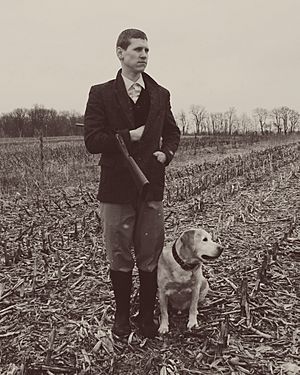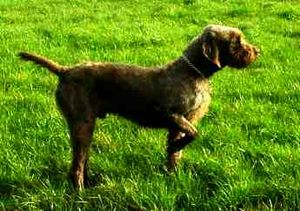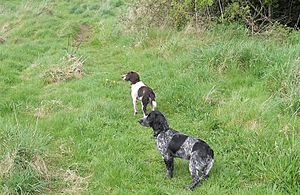Gun dog facts for kids
Gun dogs, also known as gundogs or bird dogs, are special types of dogs. They help hunters find and bring back animals, usually birds. These amazing dogs are trained to work closely with people during hunts.
Gundogs are usually split into three main groups based on what they do:
- Retrievers are experts at finding and bringing back game after it's shot.
- Flushing dogs scare birds out of their hiding spots so hunters can see them.
- Pointing breeds stand still and point their muzzle (nose) towards hidden game. This helps the hunter know exactly where the animal is.
Some dog clubs have a special "Gundog Group" for these dogs. Other clubs put them in their "Sporting Group." Some of the most popular gundog breeds include the Spaniel, Golden Retriever, and Labrador.
How Gundogs Help Hunters
Even though gundogs are grouped by their main job, many can do more than just one task. How a dog is trained makes a big difference. A well-trained gundog can be useful in many different hunting situations. Let's look at how each type of gundog helps hunters.
Pointers and Setters
When a hunter and their dog arrive in a field, the hunter might tell the dog to run in a wide circle. This helps the dog get excited energy out. It also helps the dog smell the area and get ready to find birds. Then, the dog starts searching back and forth, moving away from the hunter and then closer again. They keep doing this as the hunter walks through the field.
When a pointer or setter finds game, it freezes. It either points its nose towards the game or crouches down. If other dogs are there, they also freeze. This is called "honoring" the first dog's point. The pointing dog stays perfectly still until the hunters are ready. Hunters might say "whoa" to tell the dog to stay still.
Some dogs are trained to stay still while the hunter walks forward and scares the bird into the air. Other dogs are told to flush the bird themselves with a command like "get it!" Pointing dogs are great for birds that stay still, like bobwhite quail or grouse. This gives the hunter time to get into position. If a bird is shot down, the dogs are told to find and bring it back. Hunters might say "dead bird" or just "dead."
Flushing Dogs
When hunting upland birds, flushing dogs like spaniels and retrievers work very close to the hunter. They don't cover as much ground as pointing dogs. This is because they need to stay close enough for the hunter to shoot. Flushing dogs are often used for birds that try to run away, like pheasants. For these birds, a strong flush is needed to make them fly.
Flushing dogs are excellent at this because they don't point the birds. This gives the birds less time to escape on the ground. After a bird is flushed, the dog will sit down. This helps them watch where the bird flies and remember where it falls. A dog that does this well is called "steady to wing and shot." This steadiness is a sign of a well-trained spaniel. When a bird is shot, the dog should remember where it fell. It then waits for the command to bring the bird back to the hunter.
Retrievers

Retrievers are often used for waterfowl hunting, like ducks or geese. They can also help hunt upland birds. Waterfowl hunting often happens from small boats in cold weather. So, retrievers are expected to sit calmly and quietly until they are sent to get a bird.
When birds fly into range, a well-trained retriever will watch the hunter's gun. They will remember each bird that is shot down. This is called "marking off the gun." The downed birds are called "marks." After the shooting stops, the hunter tells the dog to bring back each bird. If a dog didn't see a bird fall, the hunter can guide the dog. They use hand and whistle signals to help the dog find the hidden bird. This is called a "blind" retrieve.
Sometimes, more birds are shot down while a dog is already bringing one back. Retrievers are taught to ignore these new birds until they finish their current job. Also, if many dogs are hunting together, retrievers learn to "honor" another dog's retrieve. This means they stay calm and quiet while the other dog is working.
Images for kids






